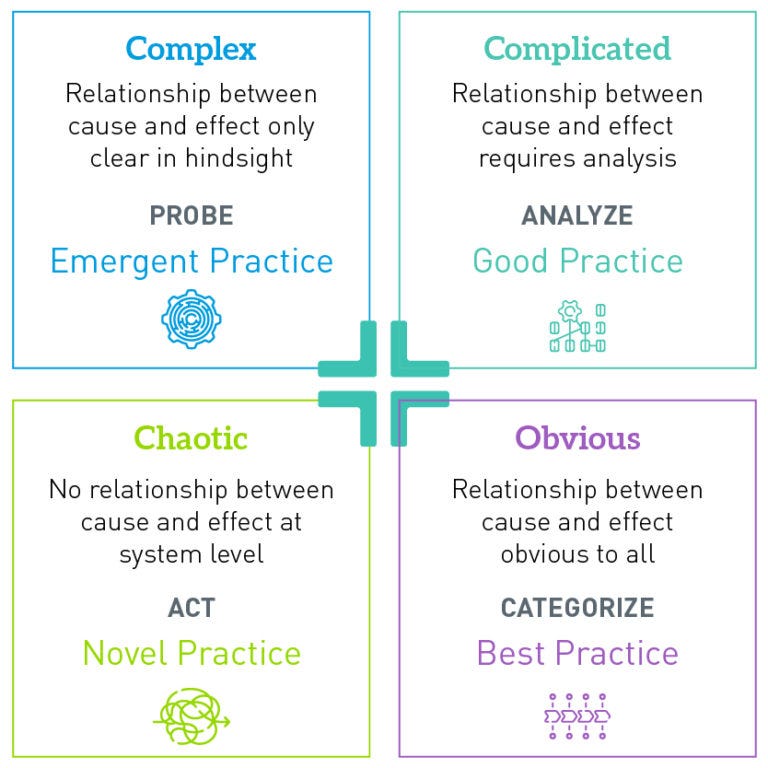I was back home in Boston this week, catching up with an old friend and his family who acted as a second set of siblings and parents growing up. My friend’s father had made a comment about the chaos my friend and I find ourselves in with two toddlers apiece (an astute, if not obvious, observation.) He said it’s something you kind of have to lean into in order to survive.
And it got me thinking - if you can embrace the chaos, you can try to channel it. You will never be able to control it and you certainly will not be able to stop it in the moment, but by recognizing it and respecting its presence, you might just have a chance to influence its direction or outcome with an eye on getting to the root source of it in the long term. At the end of the day, this is likely the best you can do.
First Step Is Admitting You Have a Problem
Like in addiction, living in denial of chaos is only going to fuel and prolong it. We may or may not be living in the most chaotic of times historically (a difficult metric to quantify), but it’s certainly the most complex of times. One major aspect of this complexity is our unwavering demand (and subsequent supply) of instant, multimedia-based news.
I just finished Erik Larson’s incredible The Demon of Unrest about the attack on Fort Sumter and the start of the Civil War. One of the things that struck me was the length of time for the back-and-forth of communication between people - both for the news media but also the generals and presidents giving crucial orders.
People would crowd around newspaper office storefronts, where publications would print out the latest telegraph reports from battles and other key events while they gathered more details for print, just to help sate the appetite of the reader. Today, we simply log onto social media or a news app to not only get these kinds of reports, but to see the horrors of things like war and terrorism in full HD color. Same amount of chaos, just with much more complexity. Stop.
Life is chaotic - to this, there is no rebuttal. The complexity of instant information (and the requisite dangers that come with it) add a certain je ne sais quoi to these seemingly constant unprecedented times.
Brush Up on Your Welsh
When we discussed the Cynefin framework months ago, we talked about how a lot of your time at work shouldn’t be spent in the lower left corner and that complexity alone does not create chaos. The goal of anyone who finds themselves in the “Chaos” portion of the framework is to get out of it into “Complex” and figure it out from there.
Easier said than done, of course. But the key here is that while it may feel that everything around you is falling apart and the relationship between cause and effect is as clear as mud, you need to act. Do something - anything - and see what happens. Did it make the situation better? Do it more. Did it make it worse? Stop and do something else. But standing around waiting for clarity to come is like hoping to catch a train whose arrival time is “Delay.”
Similes aside, one form of action that will likely end up being futile is trying to actually stop the chaos. Chaos may very well have concrete causes, but by the time it reaches the chaos stage, the time to stem those causes has long passed.
Chaos Isn’t Always Obvious
All you can do when it strikes is recognize the chaos and try to channel it or move it somewhere more productive while lessening its effect on your day/week/month and the larger organization.
This often is done through intense prioritization. There are days that by the time I get to my desk, my calendar looks like Fort Sumter once Beauregard gave the go-ahead to the Rebs (seriously, read the book.) This is when you have to get into triage mode - what has to absolutely be attended, what can move to later in the week, and what can be delegated or discarded altogether?
Chaos isn’t always some earth-shattering thing coming down from on-high in some seemingly black-swan event. There are relatively mundane forms of chaos - your calendar being one of them - that we may have simply come to accept as the norm but still takes up way too much of our time to rectify.
It’s very easy to point to something like an unexpected vendor bankruptcy or sudden leadership change as the chaos we need to fear - and they are disruptively chaotic, to be sure.
But it’s these smaller, doldrum forms of chaos that can become almost parasitic to our day-to-day. Which is why it’s important to label them properly in order to work through them and eventually try to tackle them in the long term. If we don’t recognize last minute scheduling disasters, or 11th hour strategy direction changes, or under the wire success KPI changes as the chaos that they are, we will continue to fall victim to them.
Get Out of the Chaos
Now that you’ve recognized the chaos, it’s time to get out of it. There’s no set process to extricate oneself out of a chaotic situation (it’s called chaos for a reason), but there are things you can do to try.
Triage - Chaos has a tendency to feel all-encompassing, when often we can delineate sectors of it. Try to find its boundaries and play within them when you act so you’re not disrupting things that don’t need the headache.
Communicate - The team affected by the chaos and the actors working against it need to be aligned and in lockstep to ensure everyone gets out of it as unscathed as possible. Communication is important in the slowest of times; it’s mission-critical in chaos.
Act - Whatever you do, make sure it’s something. Using the triaged parameters you need to act, get a quick read on if it made the situation better or worse, and then adjust accordingly.
Become an Epidemiologist - Chaos is typically a symptom of a larger disease. Stabilize the patient by moving from “Chaos” to “Complex” in the Cynefin framework, then make sure you revisit the underlying causes to avoid it happening again in the future.
Final Note on Chaos Agents
While we said earlier it’s hard to pinpoint the origins of chaos in the moment, there is the exception of the chaos agent. These are people who - either wittingly or unwittingly - create chaos. It can be through ambiguous communication that has consequences down the road, it could be through constantly changing direction on deliverables, or it could be the person that consistently misses meetings or gets to them late and blows them up with their own branded version of chaotic BS.
We all know who these people are, and we try to avoid them at all costs. They are characterized by high turnover on their teams, flimsy deliverables that don’t stand up to the most cursory of scrutiny, and constant overpromising and underdelivering. They also tend to be good at throwing others under the bus, which helps them keep their reign atop Chaos Mountain.
The way to deal with these folks (if you truly cannot avoid them, which should always be first priority) is the same as with chaos in general. Triage, overcommunicate, act to see what works and what doesn’t, and try - over time - to get to the root cause of the chaos.
Grab Bag Sections
WTF Chaos: While this week’s newsletter was rooted in professional chaos, for many of us the chaos simply extends to home. The evening before posting this, I got in my car for the evening drive home to find that my car battery was dead. After I waited an hour in the heat for AAA to come jump me, I walked into the house where I was able to sit down for a meal for about five minutes before my son, who has not quite mastered potty training (but is close!) announced he needed new underwear because he did a poopy in his. And it’s only Monday.
Album of the Week: In his fourth (aka “senior”) album, he proved he was the same ol’ G. Ginuwine’s The Senior was produced by R&B superproducer Bryan-Michael Cox and it delivered.
Those nostalgic for the late ‘90s/early ‘00s rap and hip hop will find a lot to like here. Some of Birdman’s best bars are featured on “Hell Yeah,” which has a music video that approaches Ja Rule and Bobbi Brown’s “Thug Lovin’” even if it doesn’t quite get there. [Ed.’s note: While they are Birdman’s best bars, that does not mean they are good.]
Other highlights include “Stingy” (extremely aughts R&B), “Bedda to Have Loved” (almost perfect chorus), “In Those Jeans” (requisite song about jeans for ‘00s R&B star), and “Chedda Brings” (even if the Nas sound-a-like feature isn’t incredible.) While the track itself is just ok, the vocal layering on “Locked Down” is A1.
Unfortunately, dear reader, there are some skips. “Sex” is trying too hard, “Big Plans,” while buttressed by a solid Method Man feature, is irreparably damaged by the opening auto-tuned lines, and “Love You More” feels like unapologetic filler (even though it was released as the fourth single off of the album.)
Give the album a spin, and while you do pull up the Wikipedia page for Swing Mob out of Rochester - it’s the label/creative collective where Ginuwine and an insane amount of talented people in 90s and 2000s hip hop got their start.
Quote of the Week: “They sell ice cream here?” - My five year old daughter browsing the cream cheese selections at a Westchester bagel shop at 8:30 on a Sunday
See you next week!











